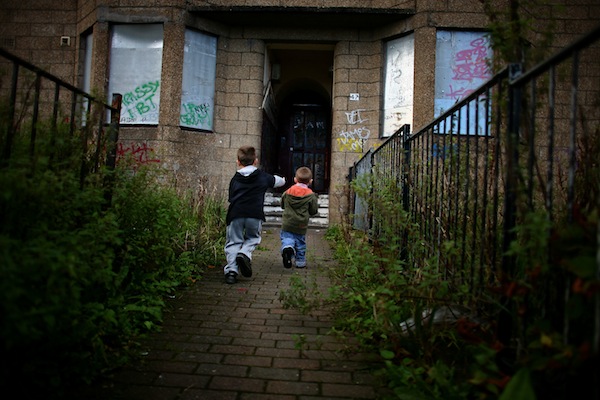
Covering the period just before the current pandemic, the statistics suggest a gradual increase in child poverty levels since the early 2010s.
Two out of the four child poverty measures in the Child Poverty (Scotland) Act show a gradual increase, and two show little change. While the poverty risk is much lower for children where someone in the household is in paid work compared to those in workless households, not all work pays enough to lift the household above the poverty line.
Over two thirds of children in poverty live in a household with someone in paid work.
There is little change in poverty levels for working-age adults and pensioners. Pensioners are less likely to be in poverty compared to working-age adults and children: 14% of pensioners are in relative poverty after housing costs, compared to 19% of working-age adults and 24% of children.
New food security analysis suggests that while most people (84%) live in households with high food security, this falls to only 60% for people in poverty. A household has high food security if people never need to worry about running out of food before they can afford to buy more, and never struggle to afford balanced meals.
Household incomes continue to rise. A typical two-adult household has £27,800 per year after tax and including benefits. Income inequality has fluctuated since the beginning of this data collection in the mid-nineties and continues to do so.
Adults under 25 are more likely to be in poverty than older adults. Non-white ethnic minorities are more likely to be in poverty compared to white ethnic groups. Muslim adults are more likely to be in poverty compared to adults of Christian and other faiths and those with no religion.
Some, but not all, of the higher poverty risk for ethnic minorities and Muslims can be explained by their lower average age. Single adults, especially single parents, and those who are divorced or separated are more likely to be in poverty compared to married, cohabiting and widowed adults.
People living in households with disabled household members are also more likely to be in poverty than those with no disabled household members.
These figures are produced in accordance with professional standards set out in the Code of Practice for Official Statistics.

Stemming the rising tide of poverty across Scotland must be the defining issue of the Holyrood election, the Poverty Alliance said as they launched their manifesto earlier this month. They call for all political parties to commit to a range of ambitious and bold action to boost incomes and reduce costs.
A Scotland for All of Us, puts forward a package of measures that all of Scotland’s political parties are being urged to back in order to loosen the grip of poverty on the lives of people across Scotland. These include:
- Committing to a Minimum Income Guarantee, which would ensure that nobody in Scotland had an income below an agreed minimum level;
- At least doubling the new Scottish Child Payment, and increasing financial support for unpaid carers and disabled people;
- Extending free bus travel to more young people and to people on low incomes;
- Ending digital exclusion, by providing low cost or free broadband to low income households;
- Attaching conditions to all public sector grants, funding and contracts that require payment of the real Living Wage and Fair Work;
- Adjusting our income tax levels and thresholds to fund greater investment in tackling poverty and exploring the use of wealth taxes;
- Giving communities a greater say over how money is spent in their local area.
The manifesto is launched at a time of growing hardship across Scotland. Even before the pandemic, over one million people – including almost one in four children – were living in poverty in Scotland. Now with many more people being swept into poverty, Scotland’s child poverty reduction targets remain unlikely to be met without more urgent action in the coming years.
Peter Kelly, Director of the Poverty Alliance, said: “In Scotland we believe in protecting one another from harm, and in the principle that every child should have every chance. Yet Scotland is also a country with unacceptably high levels of poverty and inequality.
“Addressing the rising tide of poverty that is affecting so many communities should be at the heart of every party manifesto, and with the pandemic still having an impact this is not a time for timidity. All parties must pledge to take the bold and ambitious action to boost incomes and reduce costs that we have set out, including committing to a Minimum Income Guarantee and to taking action to create a more just economy and labour market.
The next Scottish Parliament must be remembered as one that reshaped Scotland for the better, that prioritised the needs of those facing poverty and inequality, and that built a Scotland not just for some of us, but for all of us.”
Scottish Government Poverty Statistics background
The two full statistical publications are available here:
Poverty and Income Inequality in Scotland 2017-20 (data.gov.scot)
Persistent Poverty in Scotland 2010-2019 (data.gov.scot)
Poverty and Income Inequality in Scotland contains statistics on poverty, child poverty, poverty risks for various equality characteristics, household income and income inequality for Scotland. This report also includes new statistics on household food security. The data comes from the Department for Work and Pensions’ (DWP) Family Resources Survey, Households Below Average Income dataset. Comparable UK income and poverty figures are published on the same day by DWP.
Figures are presented as three-year averages of each estimate. Three-year estimates best identify trends over time. Single-year estimates are also available in the reference tables. The latest poverty and household income data in this report covers the period from April 2017 to March 2020, just before the first lockdown due to COVID-19.
Persistent Poverty in Scotland presents estimates of the proportion of people in Scotland who live in persistent poverty. The data comes from the Understanding Society Survey, and the latest statistics cover the period from 2015 to 2019.
These poverty statistics are used by the Scottish Government and other organisations to monitor progress in tackling poverty and child poverty, and to analyse what drives poverty and what works for tackling poverty and income inequality.
Key poverty measures:
Relative poverty: A household is in relative poverty if its income is below 60 percent of the middle household income in the UK (the poverty threshold). Relative poverty is a measure of whether the income of the poorest households are keeping pace with middle income households across the UK.
Absolute poverty: A household is in absolute poverty if its income is below the relative poverty threshold from 2010/11. This way, it measures whether the incomes of the poorest households are keeping pace with rising prices.
Combined low income and material deprivation identifies the number of children in families that cannot afford basic essential goods and services because of a low income (below 70 percent of the middle household income).
Persistent poverty identifies the number of people in relative poverty for three or more out of four years. People who live in poverty for several years are affected by it through their lifetime.
Household income is adjusted for household size.
The poverty publications present poverty figures before and after housing costs. Before housing costs figures are a basic measure of household income from earnings and benefits. After housing costs figures subtract spending on rents, mortgage interest payments and other unavoidable housing costs from this basic income. In Scotland, poverty statistics focus mainly on poverty after housing costs. The poverty estimates in this summary refer to relative poverty after housing costs.
Household food security: Household food security questions were newly added to the Family Resources Survey in 2019/20. They ask about whether people were worried about running out of food, had to reduce meal sizes or skip meals. Food security levels can be “high”, “marginal”, “low”, “very low”.
Further information on income and poverty statistics within Scotland is available. Poverty and income inequality statistics – gov.scot (www.gov.scot)
Official statistics are produced by professionally independent statistical staff – more information on the standards of official statistics in Scotland is available. About our statistics – gov.scot (www.gov.scot)
